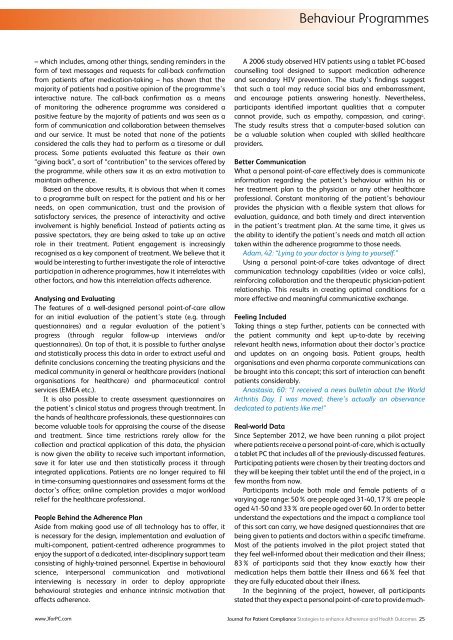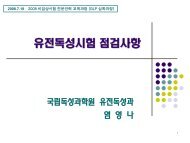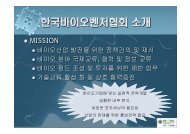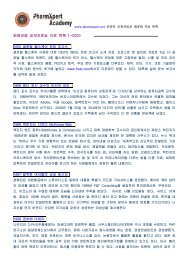PATIENT COMPLIANCE - PharmXpert Academy
PATIENT COMPLIANCE - PharmXpert Academy
PATIENT COMPLIANCE - PharmXpert Academy
You also want an ePaper? Increase the reach of your titles
YUMPU automatically turns print PDFs into web optimized ePapers that Google loves.
Behaviour Programmes– which includes, among other things, sending reminders in theform of text messages and requests for call-back confirmationfrom patients after medication-taking – has shown that themajority of patients had a positive opinion of the programme’sinteractive nature. The call-back confirmation as a meansof monitoring the adherence programme was considered apositive feature by the majority of patients and was seen as aform of communication and collaboration between themselvesand our service. It must be noted that none of the patientsconsidered the calls they had to perform as a tiresome or dullprocess. Some patients evaluated this feature as their own“giving back”, a sort of “contribution” to the services offered bythe programme, while others saw it as an extra motivation tomaintain adherence.Based on the above results, it is obvious that when it comesto a programme built on respect for the patient and his or herneeds, on open communication, trust and the provision ofsatisfactory services, the presence of interactivity and activeinvolvement is highly beneficial. Instead of patients acting aspassive spectators, they are being asked to take up an activerole in their treatment. Patient engagement is increasinglyrecognised as a key component of treatment. We believe that itwould be interesting to further investigate the role of interactiveparticipation in adherence programmes, how it interrelates withother factors, and how this interrelation affects adherence.Analysing and EvaluatingThe features of a well-designed personal point-of-care allowfor an initial evaluation of the patient’s state (e.g. throughquestionnaires) and a regular evaluation of the patient’sprogress (through regular follow-up interviews and/orquestionnaires). On top of that, it is possible to further analyseand statistically process this data in order to extract useful anddefinite conclusions concerning the treating physicians and themedical community in general or healthcare providers (nationalorganisations for healthcare) and pharmaceutical controlservices (EMEA etc.).It is also possible to create assessment questionnaires onthe patient’s clinical status and progress through treatment. Inthe hands of healthcare professionals, these questionnaires canbecome valuable tools for appraising the course of the diseaseand treatment. Since time restrictions rarely allow for thecollection and practical application of this data, the physicianis now given the ability to receive such important information,save it for later use and then statistically process it throughintegrated applications. Patients are no longer required to fillin time-consuming questionnaires and assessment forms at thedoctor’s office; online completion provides a major workloadrelief for the healthcare professional.People Behind the Adherence PlanAside from making good use of all technology has to offer, itis necessary for the design, implementation and evaluation ofmulti-component, patient-centred adherence programmes toenjoy the support of a dedicated, inter-disciplinary support teamconsisting of highly-trained personnel. Expertise in behaviouralscience, interpersonal communication and motivationalinterviewing is necessary in order to deploy appropriatebehavioural strategies and enhance intrinsic motivation thataffects adherence.A 2006 study observed HIV patients using a tablet PC-basedcounselling tool designed to support medication adherenceand secondary HIV prevention. The study’s findings suggestthat such a tool may reduce social bias and embarrassment,and encourage patients answering honestly. Nevertheless,participants identified important qualities that a computercannot provide, such as empathy, compassion, and caring 4 .The study results stress that a computer-based solution canbe a valuable solution when coupled with skilled healthcareproviders.Better CommunicationWhat a personal point-of-care effectively does is communicateinformation regarding the patient’s behaviour within his orher treatment plan to the physician or any other healthcareprofessional. Constant monitoring of the patient’s behaviourprovides the physician with a flexible system that allows forevaluation, guidance, and both timely and direct interventionin the patient’s treatment plan. At the same time, it gives usthe ability to identify the patient’s needs and match all actiontaken within the adherence programme to those needs.Adam, 42: “Lying to your doctor is lying to yourself.”Using a personal point-of-care takes advantage of directcommunication technology capabilities (video or voice calls),reinforcing collaboration and the therapeutic physician-patientrelationship. This results in creating optimal conditions for amore effective and meaningful communicative exchange.Feeling IncludedTaking things a step further, patients can be connected withthe patient community and kept up-to-date by receivingrelevant health news, information about their doctor’s practiceand updates on an ongoing basis. Patient groups, healthorganisations and even pharma corporate communications canbe brought into this concept; this sort of interaction can benefitpatients considerably.Anastasia, 60: “I received a news bulletin about the WorldArthritis Day. I was moved; there’s actually an observancededicated to patients like me!”Real-world DataSince September 2012, we have been running a pilot projectwhere patients receive a personal point-of-care, which is actuallya tablet PC that includes all of the previously-discussed features.Participating patients were chosen by their treating doctors andthey will be keeping their tablet until the end of the project, in afew months from now.Participants include both male and female patients of avarying age range: 50% are people aged 31-40, 17% are peopleaged 41-50 and 33% are people aged over 60. In order to betterunderstand the expectations and the impact a compliance toolof this sort can carry, we have designed questionnaires that arebeing given to patients and doctors within a specific timeframe.Most of the patients involved in the pilot project stated thatthey feel well-informed about their medication and their illness;83% of participants said that they know exactly how theirmedication helps them battle their illness and 66% feel thatthey are fully educated about their illness.In the beginning of the project, however, all participantsstated that they expect a personal point-of-care to provide much-www.JforPC.comJournal For Patient Compliance Strategies to enhance Adherence and Health Outcomes 25
















